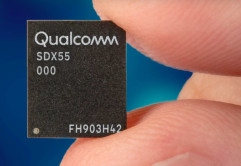
- Forum
- Special Forums
- Upcoming Technologies
- Qualcomm's Next 5G Modem Supports T-Mobile 5G
Results 1 to 1 of 1
-
02-19-2019, 01:20 PM #1
 Qualcomm's Next 5G Modem Supports T-Mobile 5G
Qualcomm's Next 5G Modem Supports T-Mobile 5G
 Qualcomm's new X55 standalone modem chip supports 5G in all major frequency bands as well as FDD and TDD modes. Support for FDD makes it the first chip to support T-Mobile's planned 5G network in the 600 MHz band. Qualcomm's first 5G modem chip, the X50, only supported TDD in the 28 GHz mmWave band. The 5G version of the Snapdragon 855 SoC supports more 5G frequency bands, but only in TDD mode. Verizon, AT&T, and Sprint all have TDD (unpaired) spectrum they will use for some or all of their initial 5G deployment. T-Mobile is focused on its existing FDD bands for 5G. The X55 also includes both 5G and 4G, and is the first chip to support Cat. 22 LTE, offering up to 2.5 Gbps speed. Furthermore, it supports dynamic spectrum sharing between 4G and 5G, for carriers planning to use existing cellular bands for both 4G and 5G simultaneously. The X55 also supports both SA (standalone) and NSA (non-standalone) 5G networks. The X55 can deliver speeds up to 7 Gbps down (and 3 Gbps up) on 5G networks. Qualcomm also introduced a new front-end 5G solution designed to work with the X55, providing the other components needed for 5G. These include a new mmWave antenna that supports band 258 (26 GHz), and is thinner than the current model, allowing 5G phones as thin as 8mm. The X55 and companion parts will appear in commercial devices by "late 2019".
Qualcomm's new X55 standalone modem chip supports 5G in all major frequency bands as well as FDD and TDD modes. Support for FDD makes it the first chip to support T-Mobile's planned 5G network in the 600 MHz band. Qualcomm's first 5G modem chip, the X50, only supported TDD in the 28 GHz mmWave band. The 5G version of the Snapdragon 855 SoC supports more 5G frequency bands, but only in TDD mode. Verizon, AT&T, and Sprint all have TDD (unpaired) spectrum they will use for some or all of their initial 5G deployment. T-Mobile is focused on its existing FDD bands for 5G. The X55 also includes both 5G and 4G, and is the first chip to support Cat. 22 LTE, offering up to 2.5 Gbps speed. Furthermore, it supports dynamic spectrum sharing between 4G and 5G, for carriers planning to use existing cellular bands for both 4G and 5G simultaneously. The X55 also supports both SA (standalone) and NSA (non-standalone) 5G networks. The X55 can deliver speeds up to 7 Gbps down (and 3 Gbps up) on 5G networks. Qualcomm also introduced a new front-end 5G solution designed to work with the X55, providing the other components needed for 5G. These include a new mmWave antenna that supports band 258 (26 GHz), and is thinner than the current model, allowing 5G phones as thin as 8mm. The X55 and companion parts will appear in commercial devices by "late 2019".
More...
«
DEAL: save $300 on the Samsung Galaxy Note 9
|
Samsung Galaxy S10, hereâs everything weâre expecting
»
Similar Threads
-
Qualcomm's Snapdragon X24 Modem Hits 2 Gbps Downloads
By cdmagurus.com in forum Upcoming TechnologiesReplies: 0Last Post: 02-14-2018, 11:35 AM -
Qualcomm's Snapdragon X50 5G Modem to Connect First 5G Networks and Devices
By cdmagurus.com in forum Upcoming TechnologiesReplies: 0Last Post: 02-08-2018, 11:26 AM -
iPhone 7 Plus Intel Modem Not Equal to Qualcomm Modem
By cdmagurus.com in forum Upcoming TechnologiesReplies: 0Last Post: 10-20-2016, 12:51 PM -
Qualcomm Says Snapdragon X50 Modem Is a 5G First
By cdmagurus.com in forum Upcoming TechnologiesReplies: 0Last Post: 10-18-2016, 10:00 AM -
Qualcomm Intros a Trio of Snapdragons and an LTE Modem
By cdmagurus.com in forum Upcoming TechnologiesReplies: 0Last Post: 02-11-2016, 09:30 AM
All times are GMT -4. The time now is 11:38 PM.
Powered by vBulletin™
Copyright © vBulletin Solutions, Inc. All rights reserved.
Template-Modifications by TMS
Copyright © vBulletin Solutions, Inc. All rights reserved.
Template-Modifications by TMS






 Reply With Quote
Reply With Quote
Bookmarks